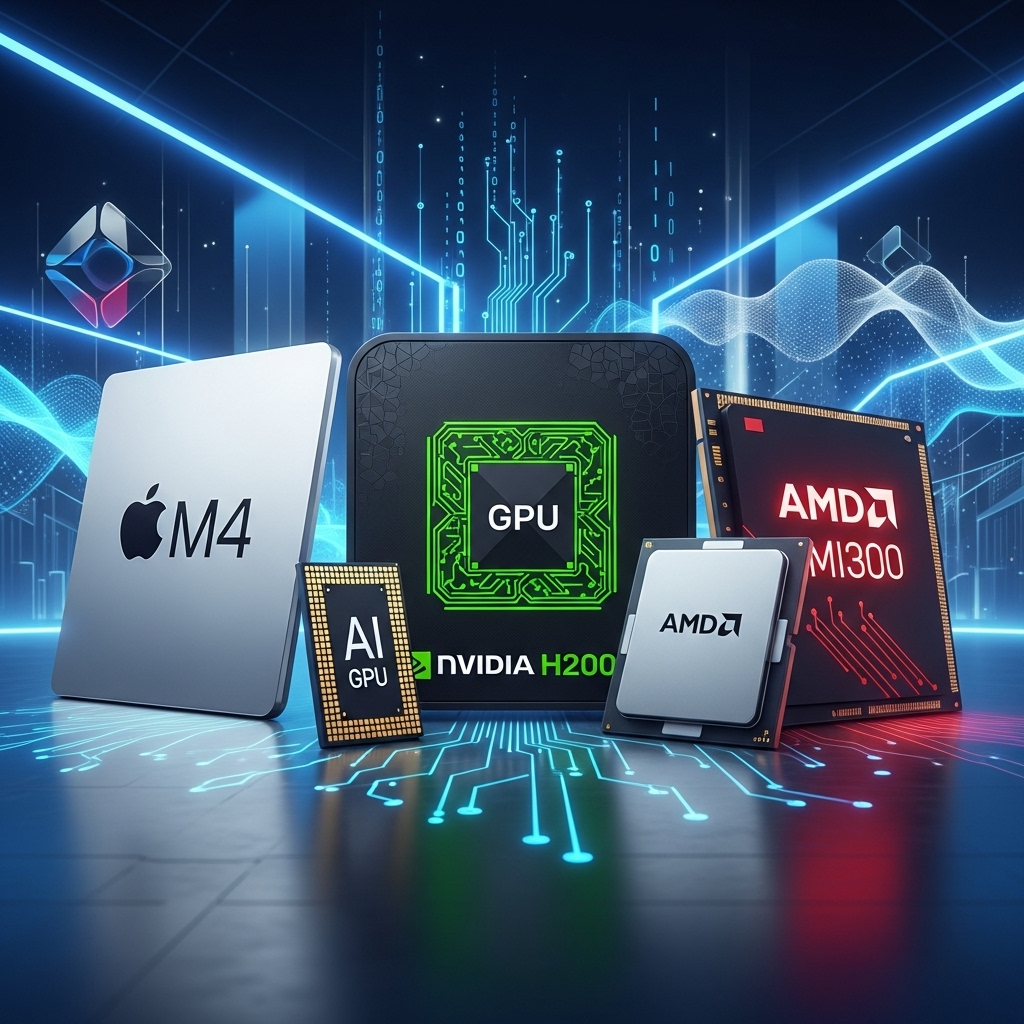AI Hardware Revolution 2025: What Business Leaders Need to Know
Apple M4, NVIDIA H200, AMD MI300 are reshaping business AI capabilities. Performance benchmarks, cost analysis, and practical implementation guide for modern enterprises.

Table of Contents
The year 2025 marks a pivotal moment in AI hardware evolution. Three major developments are reshaping how businesses approach AI implementation, and understanding these changes is crucial for any organization planning data automation initiatives.
The Big Three: Hardware That’s Changing Everything
Apple M4: AI for Everyone
Apple’s M4 chip democratizes enterprise AI with remarkable efficiency:
Key Performance Wins:
- 40% faster AI inference than M3
- 75% better performance per watt
- Native support for business AI models
- Local processing = better privacy
Perfect For:
- Document processing and contract analysis
- Real-time customer service automation
- Edge AI deployment without internet dependency
- GDPR-compliant data processing
Business Impact: Small to medium businesses can now run enterprise-grade AI locally for $5,000-15,000, with 60% lower costs over 3 years compared to cloud services.
NVIDIA H200: The Enterprise Beast
For organizations with massive AI requirements, the H200 sets new standards:
Technical Powerhouse:
- 141GB HBM3e memory (2.4x more than H100)
- 4.8TB/s memory bandwidth
- Handles 175+ billion parameter models
- Multi-workload processing capability
Enterprise Applications:
- Custom large language model training
- High-volume transaction processing (millions daily)
- Scientific computing and research
- Real-time fraud detection at scale
Investment Reality: $40,000+ per GPU, but ROI typically achieved in 12-18 months for high-volume operations.
AMD MI300: The Cost-Smart Alternative
AMD disrupts NVIDIA’s dominance with compelling value:
Strategic Advantages:
- 192GB unified memory architecture
- 30% better price-performance ratio
- Open software ecosystem (no vendor lock-in)
- Excellent for mixed AI/traditional workloads
Business Appeal:
- 80% of H200 performance at 60% of the cost
- Vendor independence strategy
- Flexible implementation options
- Strong for mid-market enterprises
Decision Framework: Which Hardware for Your Business?
Small Business (Under 50 Employees)
→ Choose Apple M4
- Investment: $5,000-15,000
- Timeline: 30-60 days implementation
- ROI: 200-300% within 12 months
Mid-Market (50-500 Employees)
→ Hybrid M4 + MI300 Strategy
- Investment: $50,000-200,000
- Timeline: 3-6 months phased rollout
- ROI: 150-250% within 18 months
Enterprise (500+ Employees)
→ Strategic Mix of All Three
- Investment: $500,000-2M+
- Timeline: 6-12 months deployment
- ROI: 120-200% within 24 months
Industry-Specific Recommendations
🏥 Healthcare & Life Sciences
- Priority: Privacy compliance + real-time processing
- Recommended: M4 for patient data, H200 for research
- Key Benefit: HIPAA compliance with faster diagnosis
💰 Financial Services
- Priority: High-volume transaction processing
- Recommended: H200 for analytics, M4 for customer service
- Key Benefit: Reduced fraud losses, better customer experience
🏭 Manufacturing
- Priority: Edge processing for quality control
- Recommended: M4 for edge deployment, MI300 for optimization
- Key Benefit: Reduced downtime, improved quality control
🛒 E-commerce & Retail
- Priority: Customer experience optimization
- Recommended: M4 for personalization, MI300 for forecasting
- Key Benefit: Higher conversion rates, reduced inventory costs
Implementation Roadmap
Phase 1: Assessment (Month 1)
- Evaluate current AI readiness
- Identify automation opportunities
- Calculate potential ROI
Phase 2: Pilot (Month 2-3)
- Deploy focused pilot projects
- Validate hardware performance
- Train internal teams
Phase 3: Scale (Month 4-6)
- Roll out to critical applications
- Implement monitoring systems
- Optimize for maximum impact
Key Success Metrics
Technical Performance:
- 200-400% processing speed improvement
- 50-70% cost reduction per AI operation
- 99.5%+ system uptime
Business Impact:
- 20-40% productivity gains
- 15-25% customer satisfaction improvement
- 30-50% reduction in manual processing
The Bottom Line
The 2025 AI hardware revolution isn’t just about technology—it’s about competitive survival. Organizations that make strategic hardware investments today will lead their industries tomorrow.
For most businesses: Start with Apple M4 for the best balance of performance, cost, and ease of implementation.
For enterprises: Consider hybrid approaches leveraging the strengths of different platforms.
For everyone: The time to act is now. The competitive advantages of superior AI infrastructure compound rapidly.
Next Steps
- Assess your AI readiness and current data processing needs
- Calculate ROI for different hardware scenarios
- Start with a pilot to validate assumptions
- Scale strategically based on proven results
The AI hardware revolution is here. Your strategic response will determine your competitive position for the next decade.
Ready to transform your data workflow? Start your free trial with 42ROWS’ AI-powered automation platform while you plan your hardware strategy.